OK.
I was trying to tell you about Rise Up and Shout! but you know the old saying about a picture and a thousand words?…check out Rise Up & Shout! MySpace.
OK.
I was trying to tell you about Rise Up and Shout! but you know the old saying about a picture and a thousand words?…check out Rise Up & Shout! MySpace.
Where 2 Start?!
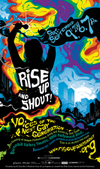 Rise Up and Shout! was a glittering evening at the beautiful Barnsdall Theater next to the exquisite Hollyhock House in Barnsdall Park. Seventeen wonderfully talented, young gay men and lesbians, ranging in age from 16 to their late-20s, danced, sang, read and otherwise entertained and regaled a packed house. Thai Rivera was the hilarious Master of Ceremonies. Already paying his dues across the country in stand-up comedy clubs, this young talent had a sharp and smart sense of humor that kept the evening moving. A year’s worth of work, headed by White Crane contributor and Advisory Board member, Mark Thompson (and his estimable partner, Malcolm Boyd) and the efforts of Don Kilhefner and the Los Angeles Men’s Medicine Circle, resulted in an inclusive rainbow of ethnicities and genders offering bright and shining acts that gave us poetry, opera, drag, the spirit of Tennessee Williams and dancing (that only made me wish my knees still worked that way!)
Rise Up and Shout! was a glittering evening at the beautiful Barnsdall Theater next to the exquisite Hollyhock House in Barnsdall Park. Seventeen wonderfully talented, young gay men and lesbians, ranging in age from 16 to their late-20s, danced, sang, read and otherwise entertained and regaled a packed house. Thai Rivera was the hilarious Master of Ceremonies. Already paying his dues across the country in stand-up comedy clubs, this young talent had a sharp and smart sense of humor that kept the evening moving. A year’s worth of work, headed by White Crane contributor and Advisory Board member, Mark Thompson (and his estimable partner, Malcolm Boyd) and the efforts of Don Kilhefner and the Los Angeles Men’s Medicine Circle, resulted in an inclusive rainbow of ethnicities and genders offering bright and shining acts that gave us poetry, opera, drag, the spirit of Tennessee Williams and dancing (that only made me wish my knees still worked that way!)
Let me see if I can recall it all (links are provided where available…some of the kids are so young and so new they don’t even have web pages….imagine that!)…musician, Richard Rocha, comedian Sandy Helen Bowles, actor Brionne Davis, folk singer Angie Evans, the Voices of G.L.A.S.S. (which, despite their name were dancers…G.L.A.S.S. is Gay and Lesbian Adolescent Social Services, one of the most important gay and lesbian services organizations in Los Angeles, providing shelter, food, therapy and other nurturing support to outcast gay and lesbian youth), rapper JenRO, filmmaker and poet Steven Liang.
Singer/songwriter Dan Holguin was followed by tenor Greg Iriart, pianist Peter Kirkpatrick, the glittering and outrageous John Quale, poet Elliott Reed and of course, being L.A., a line-up of actors including Corey Saucier, who did a wonderful reflection on aging in the gay community, Derek Ringold and a garage band, sLoW…I’m running out of breath! The panoply of talent was masterfully directed by Broadway and Disney movie veteran, Jim Pentecost. And, as if this wasn’t fabulous enough, the whole evening was a benefit for White Crane Institute.
It was wonderful. Watch for these young people…some of them are surely going to be the rising stars of tomorrow. But more importantly, as Don Kilhefner put it in his heartfelt introduction that evening, this was an opportunity for us elders to bless these young talents and welcome them into the community. In an era when transitions are rarely noted, (if not reduced to mere marketing) it was an exciting and moving evening of "Generation Conversation." A full length documentary, due out Spring 2007, is being prepared after months of following the performers and organizers up to their stellar debut at the Barnsdall Theater.
On a personal level it was my pleasure to sit for a series of portraits by noted artist  (and White Crane winter issue featured interview) Don Bachardy.
(and White Crane winter issue featured interview) Don Bachardy.
Bachardy, pictured at the left, works with almost breathtaking speed; each portrait takes under two hours (though try holding one position for that length of time and you’ll see it’s grueling work for a model). He works in acrylics and his gaze is like a laser scanner you feel taking in every inch of your face. He has pots of paints and an enameled cafeteria tray as a pallette and at times his brush simply sweeps across the watery splashes of color he’s pooled on the tray and picks up an opalescent array of colors on the brush.
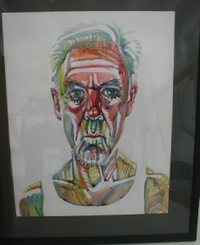 Here’s Bachardy in a self-portrait at left.
Here’s Bachardy in a self-portrait at left.
At the same time, while he is working very quickly, sketching on the paper with the colors as he captures you, on some level it would be nice to be able to smile…you know, give the world your best, friendly face? But it is physically impossible to hold a smile for that per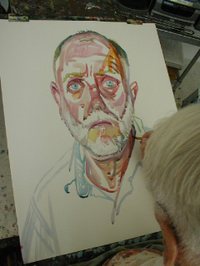 iod of time, and you end up with this deep, serious gaze being recorded, to say nothing of the actual interaction between you as the subject and Bachardy as the painter. The effect is, I will admit, slightly unsettling when you finally get to see what he has created. One person called his vision "Bachardy’s eagle eye."
iod of time, and you end up with this deep, serious gaze being recorded, to say nothing of the actual interaction between you as the subject and Bachardy as the painter. The effect is, I will admit, slightly unsettling when you finally get to see what he has created. One person called his vision "Bachardy’s eagle eye."
You can see one of the amazing acrylic portraits of me here. We did five!
My friends Robert Croonquist, Robert Rigdon and I also did the grand architectural tour of the booming downtown Los Angeles, specifically to see the spectacular Disney Music Hall which is  everything and more that it has been cracked up to be. We walked in and around the hall, climbing into some of the swooping titanium forms themselves, and in and around the truly amazing addition to Los Angeles. Imagine our delight and amazement as we were leaving to walk Grand Street to see the new R.C. cathedral, to run into none other
everything and more that it has been cracked up to be. We walked in and around the hall, climbing into some of the swooping titanium forms themselves, and in and around the truly amazing addition to Los Angeles. Imagine our delight and amazement as we were leaving to walk Grand Street to see the new R.C. cathedral, to run into none other 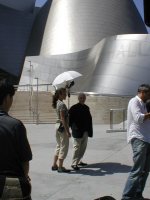 than Frank Gehrey himself being photographed on the sidewalk!
than Frank Gehrey himself being photographed on the sidewalk!
The Catholic cathedral, Our Lady of Angels, was interesting, an almost blank wall to the community in the style of the old Spanish plazas and the missions enc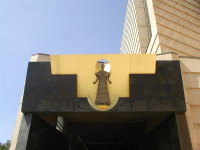 losure of various businesses. Inside is a very beautiful set of tapestries depicting the congregation of saints facing towards the altar. The "mission plaza" was a-buzz with people that Sunday. The cathedral has it’s own "Hollywood" touches, with the late Gregory Peck entombed in the mausoleum and the grand and heavy bronze doors and sconces in the cathedral created by Angelica Huston’s husband, Robert Graham.
losure of various businesses. Inside is a very beautiful set of tapestries depicting the congregation of saints facing towards the altar. The "mission plaza" was a-buzz with people that Sunday. The cathedral has it’s own "Hollywood" touches, with the late Gregory Peck entombed in the mausoleum and the grand and heavy bronze doors and sconces in the cathedral created by Angelica Huston’s husband, Robert Graham.
I’m off to Los Angeles today to attend Rise Up and Shout! the special event on Saturday, September 9th, produced by the Los Angeles Gay Men’s Medicine Circle to benefit White Crane.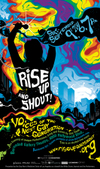
I’m really excited about it and the opportunity to visit with Malcolm Boyd and Mark Thompson, sit for a portrait with Don Bachardy and, later, work with White Crane Institute Advisory Board member, Robert Croonquist to produce an oral history video on the San Francisco Hula Palace with bon vivant and activist, Lee Mentley.
L.A. is my old stomping grounds, so it will be good to see old friends. Now if I could only remember how to drive on a freeway!
by Murray Edelman
I’ve been wrestling with the question: just what is my role as a gay elder?
In traditional cultures, elders are held in a place of honor for what they have contributed to the community and for the history and tradition they carry. In our culture, where history is recorded in books and film, traditions are constantly changing. So it is fair to ask: just what do gay elders have to offer today?
I’ve found part of the answer to be in the stories that I tell:
In 1965 I literally discovered my sexuality at the age of 21 while living in Washington D.C. A couple of weeks after locating a gay bar and having sex for the first time with a man, I was invited to an "after the bar party."
The party was mostly homosexuals. I saw two men dancing together for the first timne in my life, and their affection touched me very deeply. When I danced with women, I never felt anything special. But just seeing tenderness between men was incredibly exciting.
The suddenly the police appeared everywhere. We were all arrested. I was confused and very scared. I thought of claiming that I was the date of a woman standing near me, but I was too scared to ask her to front for me. All the feelings of guilt and fear about being a homosexual were now compounded by this arrest, possible exposure, and what it would mean for my career, given that the Federal government had required me to sign an oath that I wasn’t a homosexual.
We were marched into a cluster of paddy wagons. I made my first contact with a gay man that wasn’t laden with sexual overtones. As I relaxed, I intuitively felt the connection with being gay and the civil rights movement. I started chanting, very softly "We shall overcome, we shall overcome some day." Others in the paddy wagon joined me as we were driven to the police station for booking and possible public exposure. What a way to discover your sexuality! This was only four years before Stonewall.
Fortunately the police kept it to themselves; they booked us for disorderly conduct and we paid them a fine. That was quite a bit for one night, but it was noteworthy in another way. After we were booked, I went home with one of the men in the paddy wagon; the events of that night had brought us close and I had my first experience of touching and being held by another man. Earlier that night I witnessed gay affection for the first time; later I received grace.
The spirit that spoke to me in the paddy wagon stayed with me. Once I fully acknowledged my sexual desires, I felt betrayed by society for keeping it such a big secret. Many others chose to blame themselves. They spent years in psychoanalysis to become straight or even worse, shock treatment. Others tried to deny their sexuality by joining a seminary or staying in an unhappy marriage. I did go into therapy, but I made it clear from the beginning that I was doing it to adjust and not to change.
In the late 1960’s adjustment meant having a lover, a pet, and many kitchen appliances. It also meant keeping our sexuality to ourselves and our circle of gay friends. The cost of exposure in the workplace was too high. And even with friends we totally trusted, we might let them figure it out, but we certainly didn’t want to make them uncomfortable or "rub their face in it."
As a graduate student at the University of Chicago, I wanted to study homosexuality, but I was afraid others would make connections and I would be stigmatized in my career. Yet, while I was cautious in my actions, that conenction with the larger picture stayed with me.
In December, 1969, after the Stonewall riots, Henry Wiemhoff (one of the many lost to AIDS) and I called a small group of gay men and women together near the university to talk about Stonewall and what it all meant. Some of the attendees talked of walking around the block 10 times before coming in. Was it paranoia or precaution? A couple of years earlier the Chicago Tribune had published the names of men arrested in a bathhouse raid. The article destroyed their careers.
Most, like my lover of three years, were totally immobilized by the fear. He was furious with me that I would consider participating in the group’s first action — to be interviewed on the campus radion station. We would not give our names; we just wanted people to know we existed. He was so furious that he threatened to leave me if I was on the program. Why? Someone could recognize my voice or someone could see me at the station and then we would be at risk. (He didn’t leave, but the relationship didn’t last very long after that.)
In those early meetings, we considered telling others we were gay. It was a pretty overwhelming thought for me. Would it mean isolation from peers and professors and the stigma of being homosexual following me for my entire career? And what about my family?
But we also had a vision of change. Women and blacks had led the way for change. Also, I knew the problem with being gay was not inside me but outside. The closets were in our heads; at least we hoped so.
But it was a step into the unknown. Why risk my career and possibly my life?
Thankfully, many others have made this kind of tortured decision, but at least they had seen others come out and survive and they had a movement behind them. We didn’t have any of that. And once the decision to come out was made and acted on, it couldn’t be undone.
At a personal level it required a lot of sorting out. I was a happy, well-adjusted homosexual at the time. Why take big risks? Yet I felt so much more alive when I talked about gay politics and feminism. While I spent time reading about social change in school, I was at a popint where I could make real social change happen in my own community. For the first time I could feel my power as a leader and I liked it. (I was always the outcast in right field.) The vision powered me in ways I had never felt before. Yet, would this group, would this "movement" stay together? Am I really like them? Why not let others take the risks.
At one level it was about taking calculated risks; at another level it was about stepping into a vision of the future and being so alive, so clear and so powerful. So I started revealing my "secret" to friends, to my academic advisor…steps that could not be undone. Others came to our meetings and followed in our footsteps. We were no longer a gay discussion group at the university, but the center of the Gay Liberation movement of Chicago.
We hope you enjoyed this excerpt from the current issue of White Crane. We are a reader-written, reader-supported publication. To read more from this article, we invite you to subscribe to White Crane. Thanks!
Murray Edelman, who in addition to being an elder is a longtime innovator in the gay community, is beginning a very interesting political experiment called "Circle Voting." Check it out at www.CircleVoting.com
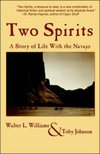 Toby Johnson, White Crane‘s former publisher and current contributing editor, has recently written a book with Walter L. Williams titled Two Spirits: A Story of Life With the Navaho. It recently received a very favorable review in the pages of the Washington Blade newspaper.
Toby Johnson, White Crane‘s former publisher and current contributing editor, has recently written a book with Walter L. Williams titled Two Spirits: A Story of Life With the Navaho. It recently received a very favorable review in the pages of the Washington Blade newspaper.
"gay authors Walter L. Williams and Toby Johnson deftly unveil the great histories of gay people as seen through the mythic and cultural expressions of the Navajo."
You can read Jesse Monteagudo’s review in the September issue of White Crane and you can purchase the book at Lambda Rising On Line or via Toby Johnson’s website at www.tobyjohnson.com
Dan and I just want to let readers know that we are aware of the problems with the current issue of White Crane (and we’ve probably learned that we shouldn’t try to publish anything when Mercury is retrograde!) particularly with the important article by Don Kilhefner.
First of all, we want you to know that the full article, without the printing errors, is on line. And, finally, we feel this article, Gay Adults! Gay Adults Where Are You?, is so important, that we will be re-running it in issue #70 so readers can read it and see the missing text, and enjoy the full idea of the piece.
Many of you have written to us about this. Both Dan and I apologize to Don and to our readers for the errors. We are working to make sure it doesn’t happen again. (I feel compelled to explain it wasn’t in the copy editing that this error happened…it happened at the printers!)
The heat, at least on the East Coast, has finally broken and it was like getting hit on the head with a hammer…it felt so good when it stopped! Saturday, all we wanted to do was get outside. We threw open all the windows, turned off the air conditioners and headed for the greenmarket at Grand Army Plaza where it looked like most everyone else had the same idea. Along with some peaches the size of baby heads, I was surprised to find beautiful rhubarb! I know now I should have bought more, but I took two pounds of it, imagining my Great Aunt Stella’s rhubarb compote that she would pour over ice cream.
That’s what I made with it, along with a nice strawberry-rhubarb-orange pie. Just chopped up a pound of the red stalks (that my local grocer asked whether it was "red celery"…which should tell you something about my local grocery options) and added some candied ginger, the chopped up rinds of one orange and a little orange juice and some lemon juice and simmered it until the rhubarb just gave up and collapsed into this rosy red puree. Cool it off and find some vanilla ice cream and it’s summer in a bowl.
Speaking of bowls, we picked up our friend, Dr. Ron, his two toddler children, and headed up to the New York Botanical Garden to check out the Dale Chihuly show installed there. What a delight!

I live two blocks from the Brooklyn Botanic Garden (note: which is called "Botanic" and the other is called "Botanical"…not sure if there is a difference or someone is just splitting hairs on us there) so I am sort of spoiled when it comes to gardens and botanic(al) ones, in particular. I couldn’t believe, first of all, how much bigger the NY Botanic Garden is. It must be twice the size of the Brooklyn one. Of course, the Brooklyn Botanic has the Brooklyn Museum sitting right in the middle of it, and directly across Flatbush which transects it on the north side, is Olmstead’s own favorite jewel, Prospect Park. So it’s all a matter of perspective, really. But the NY Botanical garden is a treat to behold. 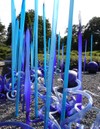
A tad more expensive, too, but I suppose if I was a member, like we are in Brooklyn, I wouldn’t have noticed. Entry fee was $6 for adults, but $20 a head to see the Chihuly, which, in retrospect, I don’t really understand since you could probably have just paid the $6 and still seen all the Chihuly’s as they are placed all through the park in the most public of places, as well as in the divine Enid Haupt Conservatory. 
Nonetheless, the glass show is, after a while, an "Alice in Glass Wonderland" experience. We walked to the Rockefeller Rose Garden with a forest of blue glass balls and spires, and on to the immense greenhouses, with exquisite, floral bowls.
Then, five-year-old and three-year-old in tow, we went back through the old forest woods where we stopped to demonstrate the helicopter-esque aerodynamic properties of maple tree seeds by tossing them off the eyebrow bridge in the middle of the woods, and on back to the Conservatory. 
We ended up having to run through the Conservatory as it was close to closing time. But that was probably the most spectacular display, with huge blown globes of colored glass floating amidst the reeds and towering in the Conservatory among the palms. We were told that on Thursday nights, from six to nine, all the pieces are illuminated. Stunning. 
Wanted to give all of you a heads up about the amazing piece written by Stephen Silha on our journal pages. Stephen has written a great piece about the importance of creative partnerships between young and old:
"I’m convinced that without creative partnerships between elders and youth, we humans will self-destruct. It’s part of evolution’s call that we co-create our future." Stephen Silha, "Culture Jamming"
Check it out!
An Online Exclusive from White Crane
Culture Jamming
Bringing creative energy to Youth-adult partnerships
BY STEPHEN SILHA
Every time we gather, we create culture.
It doesn’t matter how many of us there are… if we’re alone, with a friend/lover, or a community meeting, when eyes meet—we’re creating culture.
I became aware of this when I volunteered to help with a week-long Power of Hope workshop for teens and caring adults in 2000. When teens and adults consciously create culture together, a magical synergy of hope and experience, innocence and potency emerges.
I’m convinced that without creative partnerships between elders and youth, we humans will self-destruct. It’s part of evolution’s call that we co-create our future.
Yet, as Power of Hope’s co-founder, Charlie Murphy (yes, the gay singer/songwriter who wrote “Burning Times” and “Gay Spirit”) says, there’s a silent apartheid between youth and adults in today’s culture which makes true partnerships challenging.
“Adults project their despair about the future onto the young,” he says. “They smother them with material things and overactivity, which means they don’t get a chance to develop their interior side.”
I’ve been doing work with youth for many years—in journalism, in community service, and most recently in a series of youth-adult dialogues on Vashon Island, near Seattle, where I live.
The essence of the youth-adult dialogues, which we (a group of youth and adults from my community) learned from going to Whidbey Island and experiencing a Power of Hope dialogue, is creating a field of common creative play as a predecessor to conversation.
“Youth thrive in the company of adults who are passionate about life, alive to their own creativity,” Charlie says. Gay men, in many cases, are ready to create these partnerships.
It’s not easy with all the built in stereotypes and prejudices we and they carry about the “other.” This includes sexual stereotypes on all sides of the equation.
Why not apply some of the principles that underlie Radical Faerie culture to relationships between youth and elders?
For example, subject-subject consciousness. What does it look like when neither the youth nor the elder is an object—both are subjects…of their own lives, of the community, of their relationships? Or as Tony Kushner might say, what if we look at each other (across the generations) as prophets?
“Adults need to pursue their own calling so youth can do the same, appropriate to their stages in life,” Charlie suggests. “Education could change from a dead one-way street—fitting kids into roles—to a vibrant conversation, where everybody is finding their calling. We need to create a zone where we’re all on our creative edge.”
Using creative writing, theater improv, visual and verbal art, youth and adults can create together, raising their voices and putting out visions of a future that’s fun, heart-centered, whole.
Why not acknowledge the inner life? Of ourselves, of each other. A little silence welcomes those inner voices. The way of the heart circle—speaking and listening from a deeper place—can enrich even one-on-one encounters.
Charlie has found that “young people are deeper, more caring than we generally give them credit for. So much so, they don’t realize it themselves.” This is also true of the young parts of ourselves, which are awakened and enlivened by creative contact with youth.
Another faerie principle that might help with intergenerational communication is “askance” —looking at things sideways, from different angles, with a dose of humor.
I was amazed when I helped a group of kids at a Power of Hope summer camp create a “Zine” which they called “Rising.” Instead of asking people to write articles, they created graffiti boards around the camp, in bathrooms and other places, where people felt free to express themselves. The Zine was filled with wisdom and silliness from those graffiti boards—a new news source in the future?
As we reinvent various aspects of our culture that need fixing—health care, communication, transportation, governance, relationship to spirit—collaborations between those who’ve “seen it all” and those who “see a better way” will make it possible.
For more information on Power of Hope, visit their website.
Stephen Silha is a freelance writer, facilitator and communications consultant in Washington State. He can be contacted via his website. www.goodnewsgooddeeds.org
Attended the memorial service for Eric Rofes at the LGBT Community Center in Manhattan last night. I met earlier with Chris Bartlett, Eric’s partner in the Gay Men’s Leadership Academies to discuss the planning of the second Academy in September (if you haven’t registered go here) and then we made our way over to the Center for the service.
We had a little time to sit. Crispin Hollings, Eric’s handsome husband, was there and we visited a while. Then Perry Brass arrived so we all talked about his early organizing work.
The memorial service was inspiring and touching. The speakers included a childhood friend of Eric’s from Commack, David Klafter, who spoke lovingly of his friend, and Eric’s special gift for friendship. Suzanne Pharr, the first director of the historic Highlander Research and Education Center in Tennessee. Richard Burns, Executive Director of the LGBT Community Center, and an old friend of Eric’s from his Boston days spoke movingly of Eric’s early role in lifting the then very localized gay movement to national standing and the organizing of the first March on Washington.
Equally importantly…shockingly…infuriatingly, Burns related the story of how the coroner’s office in Provincetown initially refused to acknowledge Crispin and Crispin’s wishes for Eric to receive an autopsy and be cremated. If there was any doubt of how tenuous our rights are as gay people…here is a man who had been one of the primary organizers of the GLBT Rights movement, who had the mayor, the executive directors of NGLTF, Lambda Legal and every imaginable power of attorney, piece of paper, domestic partner registration in hand…in a state where gay residents even HAVE the right to marry, and these authorities needed to be reminded of their own laws, and Crispin’s rights as Eric’s life partner.
We were serenaded not once, but twice by the inimitable New York City Gay Men’s Chorus, singing "Love Lives On" and "Sing Me To Heaven."
The speakers were a dazzling panel of bold names from our community: Urvashi Vaid, Jeff Montgomery from the Triangle Fund, Chris Bartlett, of course, and the brilliant humorist and monologist, Kate Clinton (who wryly, sadly noted, "Eric had one heart attack and dies. Dick Cheney has four and doesn’t even seem to be phased by it. Maybe there is no justice?") Clinton spoke of having had coffee with Eric his last morning in Provincetown…any town…and remembered how he insisted, always, on speaking of his erotic life; Insisting that we could not work to achieve sexual liberation and NOT talk about sex!
Crispin, still obviously mourning deeply, related his walk through Eric’s place in Provincetown that morning he arrived, seeking he said, some presence of Eric. His grief was palpable, but the strength of the love these two men shared was right there, too.
Finally, Amber Hollibaugh read from Eric’s landmark Reviving the Tribe:
"We cannot bring the dead back to life…Finding ways to regain mental health and perspective will be challenging, but gay men are not alone in these tasks. We are part of a large and increasing population of Americans who somehow manage to face the bizarre psychic deformations and powerful existential questions which arise in the wake of extreme events. We stand alongside political refugees from Eastern Europe, immigrants who have survived the Cultural Revolution in China or terrorism in Central America, combat veterans… Our plight is shared by abused children and battered women, as well as people who live their entire lives victimized by poverty, gang violence and drugs. We are not alone in our suffering.
…I hope to live my middle-age years with the ability to be present and engaged in a way I haven’t been able to be for most of the past decade…When I enter old age, I hope to be able to speak to people abou the worlds in which I’ve lived, and look back with a perspective that integrates anger and grief with appreciation and even humor.
…To see men embrace and love each other in response to neither loss nor terror revives my dreams from a life long ago. To watch masses of men dance together, celebrating raw life-giving powers of music and desire, forces me to acknowledge that the human spirit is not easily subdued. When once again two men can kiss hard on the mouth, as neither victims nor survivors nor captives, then peace and order will settle over the tribe and life will again move forward."
We are so much poorer a people without this man and so much richer for his having been with us.